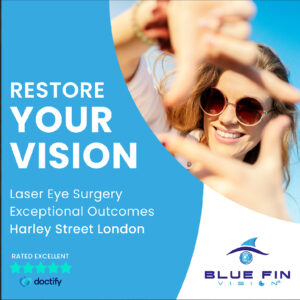Refractive lens exchange (RLE) is rapidly becoming one of the most sought-after surgical options for individuals looking to permanently correct vision problems, particularly those who are not suitable candidates for other types of corrective surgery, like LASIK. This procedure is especially beneficial for individuals over the age of 40 who are experiencing age-related changes in vision, such as presbyopia, or those with high refractive errors or cataracts.
Unlike LASIK, which reshapes the cornea to correct refractive errors, RLE addresses issues by replacing the eye’s natural lens with a synthetic intraocular lens (IOL). This makes RLE a versatile solution that can treat a range of vision problems, including nearsightedness (myopia), farsightedness (hyperopia), astigmatism, and presbyopia, a condition that makes it increasingly difficult to focus on nearby objects due to the natural lens losing flexibility over time.
For patients with presbyopia, RLE offers a particularly effective solution. The artificial IOL implanted during the procedure is designed to restore the eye’s ability to focus at various distances, reducing or eliminating the need for reading glasses. Multifocal IOLs are a popular option for this, as they provide clear vision at multiple distances, allowing patients to see both near and far objects without the need for additional corrective lenses. Accommodating IOLs also provide a dynamic solution by mimicking the natural lens’s ability to change shape to focus on different distances, offering a more natural experience.
Moreover, RLE provides a comprehensive solution for those with high refractive errors, which are sometimes too severe to be addressed with traditional laser treatments. People with high myopia or hyperopia often find their vision difficult to correct with glasses or contact lenses, but RLE can offer a lasting improvement by replacing the natural lens with a custom-designed IOL. Toric IOLs, specifically designed for individuals with astigmatism, are also available. These lenses correct the irregular shape of the cornea, providing better overall clarity and stability of vision.

The permanent nature of the results is one of the Refractive lens exchange key advantages of RLE. Unlike glasses or contact lenses, which require regular replacement, the IOL used in RLE is designed to last a lifetime. This long-term solution eliminates the need for ongoing adjustments or prescription updates, which can be especially liberating for individuals tired of constantly managing their corrective eyewear. In addition, because the lens is an internal part of the eye, it is not subject to the same wear and tear that external devices like glasses or contacts experience.
RLE can also be a preferred option for individuals with cataracts. Cataracts occur when the natural lens of the eye becomes cloudy, impairing vision. When combined with cataract surgery, RLE not only addresses the cataract by removing the cloudy lens but also corrects refractive errors by implanting a custom IOL. This dual benefit makes RLE an excellent choice for individuals who need cataract surgery but also want to improve their vision beyond what glasses or contact lenses can provide.
While the procedure is considered safe, it does carry some risks. As with any surgery, there is a small chance of complications such as infection, inflammation, or retinal detachment. Some patients may also experience visual disturbances like glare, halos around lights, or difficulty with night vision, although these issues are typically temporary and improve over time. Serious complications are rare, and most patients experience a smooth recovery process with significant improvements in their vision.
The recovery from RLE is generally quick, with many patients noticing clearer vision within days of the procedure. Most individuals can resume their normal activities after a few days, although it is important to follow post-operative care instructions to ensure the healing process goes smoothly. Patients are usually prescribed eye drops to prevent infection and reduce inflammation, and they may be asked to avoid activities such as heavy lifting or rubbing their eyes for a short period after surgery. Regular follow-up appointments are crucial to monitor the healing process and check the positioning of the IOL.
For many patients, the long-term benefits of RLE are well worth the small risks and the brief recovery period. The ability to see clearly without the need for glasses or contact lenses can significantly improve quality of life. Activities such as reading, driving, and engaging in outdoor sports become easier and more enjoyable, and many RLE patients experience a greater sense of freedom from the constant need to manage their vision correction.
In conclusion, refractive lens exchange offers a highly effective solution for a wide range of vision problems, particularly for individuals who are experiencing the effects of aging or who have refractive errors too severe to be corrected by other means. By permanently replacing the natural lens with a customized IOL, RLE provides lasting vision improvement, reducing or eliminating the need for glasses or contact lenses. With its high success rates and ability to treat multiple vision issues simultaneously, RLE is an increasingly popular choice for individuals seeking long-term, reliable vision correction. As technology continues to advance, the range of IOL options will only expand, further improving the outcomes and patient satisfaction with this life-changing procedure.
